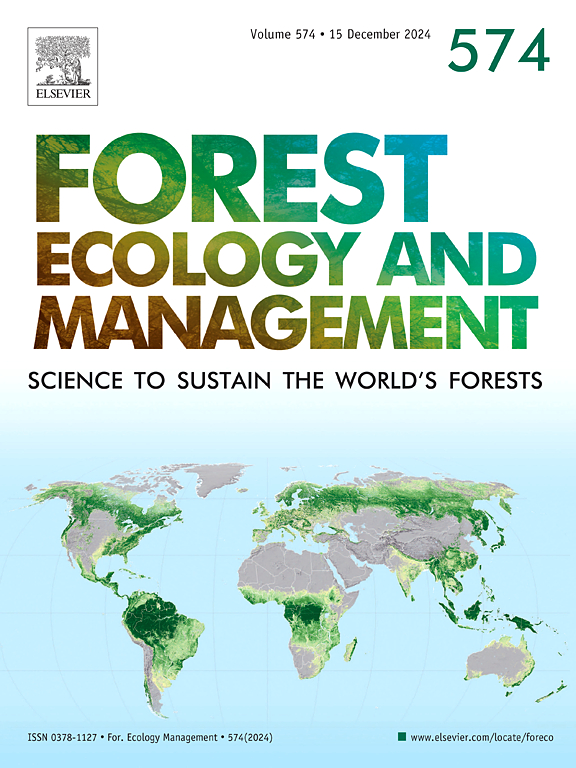自底向上和自顶向下的作用力调节云杉芽虫(鳞翅目:扁桃科)在白云杉再生中的生物学性能
IF 3.7
2区 农林科学
Q1 FORESTRY
引用次数: 0
摘要
由于与植物性状和天敌压力相关的潜在机制以依赖于环境的方式相互作用,幼树通常极易受到昆虫食草性的影响,这种影响很难预测。本研究比较了人工林和阔叶林下自然更新的云杉幼树上的云杉芽虫(Choristoneura fumiferana)受到的自下而上和自上而下的作用力。云杉芽虫是加拿大东部最重要的爆发针叶树落叶者,鉴于其对爆发后森林演替的重要性,我们的目标是更好地了解芽虫对幼树的食草性。在加拿大曲海省西北部进行了为期4年的实地调查,比较了两种生境的植物物候、虫虫密度、落叶率、捕食者种群和寄生情况。我们还设计了哨兵幼虫的操纵实验来评估这些栖息地中自下而上和自上而下的力量。野外调查表明,人工林的芽期物候较早,影响了与滞育出芽的同步性。野外调查结果还显示,人工林的幼虫密度略高,幼虫寄生率较低,但当年生长落叶量差异不显著。自底向上试验表明,人工林的幼虫生物学性能略好,蛹质量较高。自上而下的实验表明,天然森林的捕食和寄生率略高。总之,我们的研究结果表明,控制昆虫脱叶虫种群的机制是如何依赖于环境的。在人工林中,自下而上和自上而下对云杉芽虫的压力似乎略有缓解,导致这种森林害虫的生物性能略有改善,种群密度较高。然而,差异非常小,没有观察到对落叶的影响。本文章由计算机程序翻译,如有差异,请以英文原文为准。
Bottom-up and top-down forces regulate spruce budworm (Lepidoptera: Tortricidae) biological performance on regenerating white spruce
Young plantation trees are often highly vulnerable to insect herbivory in ways that are difficult to predict as underlying mechanisms linked to plant traits and natural enemy pressure interact in context-dependent ways. We compared bottom-up and top-down forces acting on spruce budworm (Choristoneura fumiferana) on young white spruce (Picea glauca) trees in plantations vs in natural regeneration under hardwood canopy. The spruce budworm is the most important outbreaking conifer defoliator in Eastern Canada, and we aim to better understand budworm herbivory on young trees, given its importance for post-outbreak forest succession. We conducted a 4-year field survey in Northwestern Québec, Canada, to compare plant phenology, budworm density, defoliation rates, predator populations, and parasitism between the two habitats. We also designed manipulative experiments with sentinel larvae to assess bottom-up and top-down forces in these habitats. The field survey showed earlier budburst phenology in plantation trees, affecting synchronization with budworm emergence from diapause. Field survey results also included slightly higher budworm density and lower larval parasitism in plantations, but no significant difference in current-year growth defoliation. The bottom-up experiment showed slightly better budworm biological performance, indicated by higher pupal mass, in plantations. The top-down experiment suggested slightly higher predation and parasitism in the natural forests. Together, our results show how mechanisms controlling insect defoliator populations are context-dependent. In plantations both bottom-up and top-down pressures on the spruce budworm appear slightly eased, leading to marginally better biological performance and higher population density of this forest pest. However, differences are so minor that no impact on defoliation is observed.
求助全文
通过发布文献求助,成功后即可免费获取论文全文。
去求助
来源期刊

Forest Ecology and Management
农林科学-林学
CiteScore
7.50
自引率
10.80%
发文量
665
审稿时长
39 days
期刊介绍:
Forest Ecology and Management publishes scientific articles linking forest ecology with forest management, focusing on the application of biological, ecological and social knowledge to the management and conservation of plantations and natural forests. The scope of the journal includes all forest ecosystems of the world.
A peer-review process ensures the quality and international interest of the manuscripts accepted for publication. The journal encourages communication between scientists in disparate fields who share a common interest in ecology and forest management, bridging the gap between research workers and forest managers.
We encourage submission of papers that will have the strongest interest and value to the Journal''s international readership. Some key features of papers with strong interest include:
1. Clear connections between the ecology and management of forests;
2. Novel ideas or approaches to important challenges in forest ecology and management;
3. Studies that address a population of interest beyond the scale of single research sites, Three key points in the design of forest experiments, Forest Ecology and Management 255 (2008) 2022-2023);
4. Review Articles on timely, important topics. Authors are welcome to contact one of the editors to discuss the suitability of a potential review manuscript.
The Journal encourages proposals for special issues examining important areas of forest ecology and management. Potential guest editors should contact any of the Editors to begin discussions about topics, potential papers, and other details.
 求助内容:
求助内容: 应助结果提醒方式:
应助结果提醒方式:


